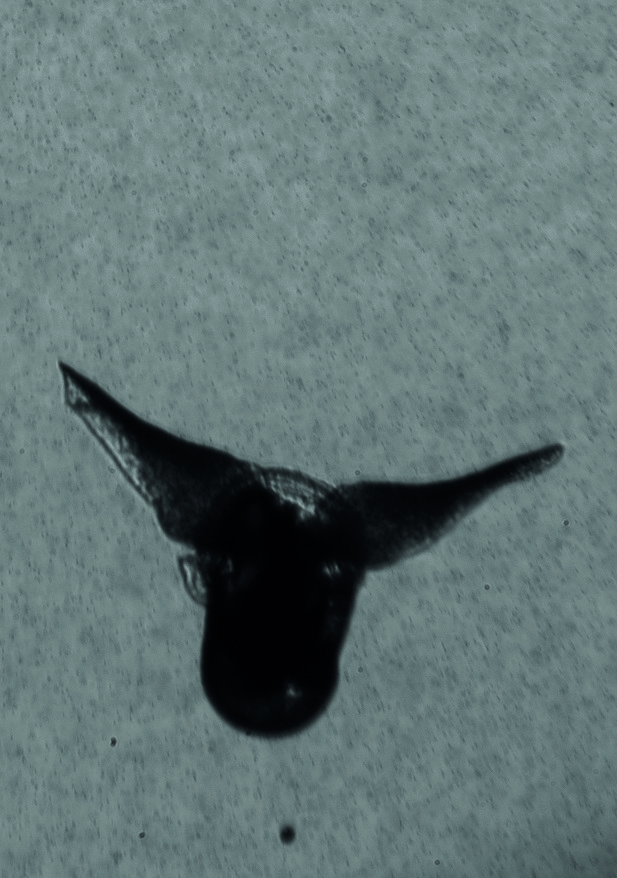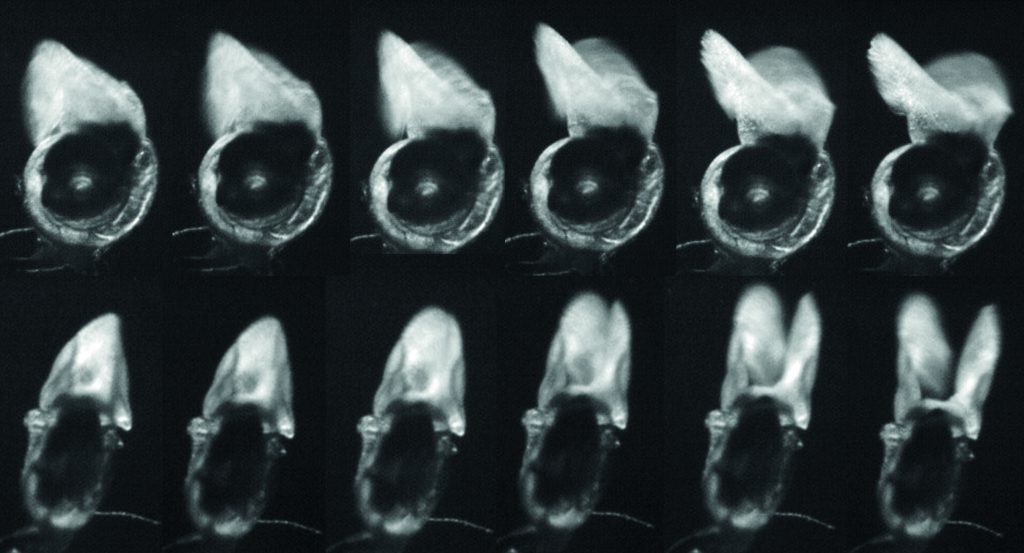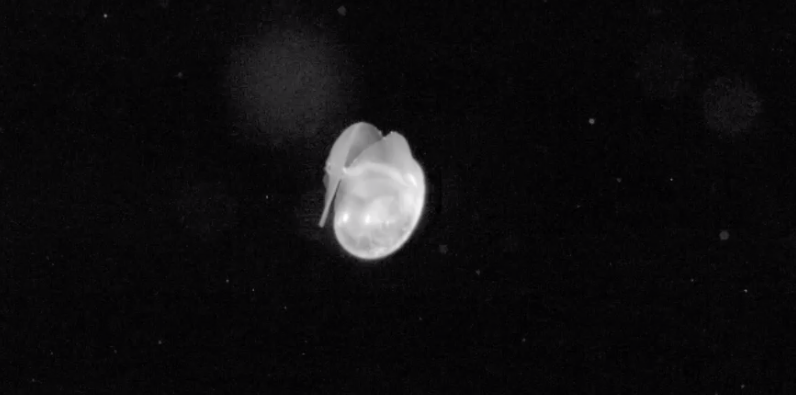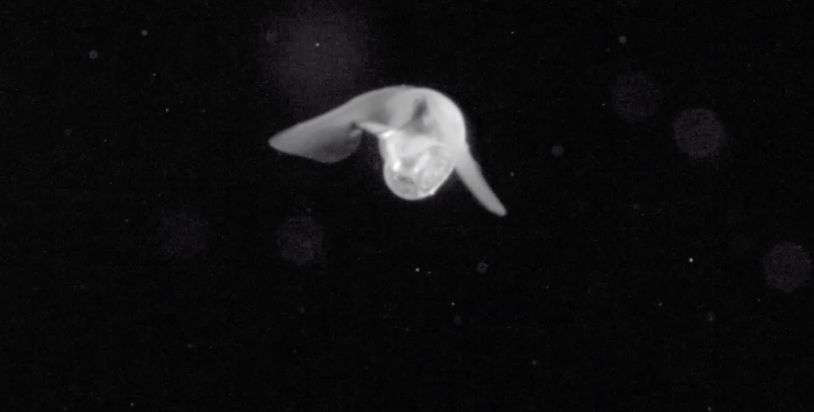Dr Jeannette Yen – Flying Sea Snails as Potential Indicators of Ocean Acidification
Ocean acidification, caused by increasing atmospheric carbon dioxide, is having a negative impact on marine ecosystems. To effectively respond to the issue, a deep understanding of it is absolutely necessary. At the Georgia Institute of Technology, Drs Jeannette Yen, David Murphy, Deepak Adhikari and Don Webster propose a novel method for monitoring ocean acidification. Their approach involves a miniscule marine snail and investigating how changes in ocean acidity affect its unique locomotive behaviour.
A Significant and Ongoing Problem
Ocean acidification is caused primarily by the absorption of carbon dioxide from the atmosphere. Atmospheric carbon dioxide, which has been on the rise for some time due to human activity, essentially dissolves into sea water to form carbonic acid – making the ocean more acidic.
While estimates vary, the National Oceanic and Atmospheric Administration (NOAA) suggests that the ocean absorbs about 30% of the carbon dioxide that is released into the atmosphere. That’s a lot of carbon dioxide – and the resulting acidification is a real problem for marine ecosystems. In fact, it is often referred to as ‘climate change’s evil twin’.
The problem lies in the fact that acid dissolves calcium carbonate – a chemical used by organisms such as oysters, clams, sea urchins, corals and calcareous plankton to make their shells, skeletons and other structures. Although living creatures are resilient and can adapt to changing conditions, the sheer quantity of atmospheric carbon dioxide and rate of uptake by oceans all over the world is presenting quite a challenge for these marine organisms.
One of those organisms is the Thecosome pteropod. Thecosome pteropods are a type of miniscule marine snail characterised by a most bizarre feature – thin, wing-like swimming organs. Hence, Thecosome pteropods are more commonly known as ‘sea butterflies’. Dr Jeannette Yen and her team at Georgia Institute of Technology’s School of Biological Sciences and School of Civil and Environmental Engineering have devoted much time to studying this organism. What they have discovered about the anatomy and locomotion of the sea butterfly is truly amazing. However, these creatures also have a unique role to play in the study of ocean acidification.

CREDIT: David Murphy and Ferhat Karakas
The Sea Butterfly’s Peculiar Locomotion
In research published in 2012, Dr Yen’s colleague Dr David Murphy conducted detailed studies of sea butterfly locomotion. During this project, they were able to determine average speeds, stroke frequencies and general swimming paths by studying the trajectories of free-swimming individuals. In their paper, they noted that sea butterflies ‘ascend along a sawtooth trajectory in mostly linear and sometimes helical paths. Mean speeds varied from 13 to 44 mm/s for straight ascents and slightly more for helical paths. During swimming, the stroke cycle caused oscillations in body orientation, whereas sinking is characterised by smooth straight descents.’
Another intriguing discovery was that sea butterflies employ the so-called Weis-Fogh clap-and-fling mechanism when moving through water. The Weis-Fogh clap-and-fling is a characteristic wing stroke that proceeds in a figure-of-eight pattern. It is used commonly by insects to produce lift and fly about in the air. Dr Yen’s colleagues later focused on this most fascinating behaviour to confirm that, despite living deep underwater, sea butterflies do indeed employ this wing stroke mechanism. However, doing so would require a specialist technique.
Hydrodynamic Studies Using Tomographic PIV
Particle Image Velocimetry, or PIV, is a technique used for studying the properties of fluids, such as flow velocity. It works by seeding the flow with ‘tracer’ particles, which are assumed to faithfully follow the related flow patterns. The movement of these over an illuminated plane is monitored using special digital cameras. The images produced offer insights into the flow dynamics and enable scientists to make calculations of speed and direction (flow velocity).
PIV is commonly used to study the locomotive characteristics of marine creatures. However, typical PIV techniques have their limitations. Of note is their inability to accurately measure flow dynamics on the small scale – the scale required to study the locomotive attributes of sea butterflies. This presented a challenge to Dr Yen and her team. So, concurrent with their studies of sea butterfly locomotion discussed above, the team adapted the tomographic PIV technique to zooplankton flows. This is known as ‘high-speed tomographic PIV’.
In 2012, Dr Yen and her team developed the technology, and later in 2016, they even incorporated it into a portable unit, which they took to Antarctica. Over the course of developing it, they found that it does indeed address many of the challenges associated with more traditional techniques. Most importantly, it proved to be effective on the small scale, and the team was able to study the flow dynamics associated with the high-speed escape of a tiny crustacean called a copepod in truly remarkable detail. Based on this success, the team moved forward with using high-speed tomographic PIV to further study other miniscule marine creatures such as sea butterflies.

‘Our goal is to develop a behavioural assay to provide an early warning of the effects of ocean acidification.’
Further Studies of Sea Butterfly Locomotion
As was mentioned above, Dr Yen and her team had evidence that sea butterflies employ a Weis-Fogh clap-and-fling mechanism when moving through water. Subsequently, in research published in 2016, they utilised high-speed tomographic PIV to confirm that this was the case. As explained in the associated paper, sea butterflies do indeed ‘fly’ underwater using a Weis-Fogh clap-and-fling mechanism at a high angle of attack in much the same way that tiny insects fly in air.
Why is was this discovery significant? Well, the locomotive method employed by the sea butterfly is lift-based. In the world of miniscule marine creatures this is most unique. As is highlighted in the team’s associated paper, other zooplankton (organisms that drift in the ocean, including copepods, krill and jellyfish) almost always employ drag-based swimming techniques. In other words, sea butterflies ‘fly’ through the water rather than ‘paddling’. Indeed, referring to Thecosome pteropod as the ‘sea butterfly’ is most appropriate. However, as was alluded to at the outset, these tiny little creatures and their unique locomotive characteristics offer insights into a far bigger issue – acid acidification.

The Relationship Between Pteropods and Ocean Acidification
In 2012, Dr Yen and her team published an interesting observation. They noted that the wing-beat frequency of the sea butterfly decreased with body size. Although not the focus of their project, this turned out to be a significant observation. How so? Given that sea butterflies possess a calcium carbonate-based shell that can be easily broken down by acids, rapidly rising ocean acidity would obviously have an impact on the size and weight of sea butterflies. This, in turn, would affect the way they move through the water. Could the locomotive behaviour of the sea butterfly, therefore, be an indicator of ocean acidity?
In their work with the portable high-speed tomographic PIV instrument, during which they studied shelled Antarctic pteropods at Palmer Station, Antarctica, they made this inference: ‘[Shelled pteropods] are important organisms to study because of their novel swimming characteristics and the potential for these characteristics to serve as indicators of ocean acidification.’ Indeed, as they mentioned in the associated paper, increased ocean acidity dissolves the shells of sea butterflies, which reduces their weight, and affects their locomotion. In summary, changes to the locomotive characteristics of shelled planktonic species such as the sea butterfly may, in fact, be an indicator of increasing ocean acidity.

Insights from a Tiny World
Of course, as is often the case with ground-breaking work, further studies are required to establish and validate the link. In fact, that very much describes the current work of Dr Yen and her team. As she highlights, ‘Our goal is to develop a behavioural assay to provide an early warning of the effects of ocean acidification. Our focus is on the plankton, a key link in the aquatic food web. The behaviour of interest is the locomotion by [the sea butterfly]’. Work has already begun on this project and detailed studies of planktonic locomotion are underway.
To summarise, Drs Yen, Murphy, Adhikari and Webster aim to document the biomechanics of a range of planktonic species, including the sea butterfly, and input the data acquired into computational fluid dynamics models. These models, in turn, will be used to predict how their behaviour will change in relation to variations in shell weight. If the link between ocean acidification and shell weight reduction is established and validated, planktonic locomotion could be used as an indicator of ocean acidification.
It goes without saying, this is most certainly intriguing work. Not only is it fascinating to learn about the unique anatomy and behaviour of the sea butterfly, it is interesting to learn how this intricate process can be affected by a gradually changing environment. Given the threat that ocean acidification presents to marine ecosystems, the insights acquired in this research will be invaluable. In conclusion, Dr Yen’s research offers an incredibly detailed insight into a massive environmental problem – from the tiny world of the sea butterfly.
Reference
https://doi.org/10.33548/SCIENTIA363
Meet the researcher

Dr Jeannette Yen
Center for Biologically Inspired Design
School of Biological Sciences
Georgia Institute of Technology
Atlanta, GA
USA
Dr Jeannette Yen received her PhD in biological oceanography from the University of Washington, Seattle in 1982. She currently serves as Professor of Biology at the Georgia Institute of Technology, and has been with the institution since 2000. She is also the Director of Georgia Tech’s Center for Biologically Inspired Design. The Center brings together a group of biologists, engineers, designers and physical scientists who seek to facilitate interdisciplinary research and education for innovative products and techniques based on biologically-inspired design solutions. For example, she and her colleagues have been working on understanding the unique locomotive characteristics of the Thecosome pteropod, commonly known as the sea butterfly. Specifically, they are researching the relationship between these characteristics and changing oceanic conditions, with emphasis on ocean acidification. Dr Yen has also contributed much to the public communication of science. For example, she recently collaborated with Mel Chin to project plankton above Times Square using augmented reality.
CONTACT
E: jeannette.yen@biology.gatech.edu
W: http://biosci.gatech.edu/people/jeannette-yen
KEY COLLABORATORS
Dr Donald R. Webster, Georgia Institute of Technology
Dr David W. Murphy, Georgia Institute of Technology
Dr Deepak Adhikari, Georgia Institute of Technology
FUNDING
US National Science Foundation
FURTHER READING
D W Murphy, D Adhikari, DR Webster, J Yen, Underwater Flight by the Planktonic Sea Butterfly, Journal of Experimental Biology, 2016, 219, 535.
D Adhikari, DR Webster, J Yen, Portable Tomographic PIV Measurements of Swimming Shelled
Antarctic Pteropods, Journal of Experiments in Fluids, 2016, 57, 180.
Y Chang, J Yen, Swimming in the Intermediate Reynolds Range: Kinematics of
the Pteropod Limacina helicina, Journal of Integrative and Comparative Biology, 2012, 52, 5.
DW Murphy, DR Webster, J Yen, A High-Speed Tomographic PIV System for Measuring
Zooplanktonic Flow, Journal of Limnology and Oceanography: Methods, 2012, 10, 12.

Creative Commons Licence
(CC BY 4.0)
This work is licensed under a Creative Commons Attribution 4.0 International License. 
What does this mean?
Share: You can copy and redistribute the material in any medium or format
Adapt: You can change, and build upon the material for any purpose, even commercially.
Credit: You must give appropriate credit, provide a link to the license, and indicate if changes were made.
More articles you may like
Dr Lifei Wang | Can Species Distribution Models Inform Us About Future Ecosystems?
The world is buzzing with news about how human activities and climate shifts are reshaping our ecosystems. Have you ever wondered how life will adapt to this rapidly changing world? Ecologists might be able to predict how different species will live in future using computer simulations. Dr Lifei Wang at the University of Toronto Scarborough investigates how different stimulations work under varying conditions to provide new insights into what may lie ahead.
Dr Yong Teng | Improving the Outlook for Head and Neck Cancer Patients
Dr Yong Teng at the Emory University School of Medicine is working with colleagues to overcome the high mortality of individuals diagnosed with cancers affecting the head and neck. One of his approaches is based on understanding the particular mechanisms of the ATAD3A gene, which new insights suggest are closely related to cancers affecting the head and neck.
Dr Tsun-Kong Sham – Dr Jiatang Chen – Dr Zou Finfrock – Dr Zhiqiang Wang | X-Rays Shine Light on Fuel Cell Catalysts
Understanding the electronic behaviour of fuel cell catalysts can be difficult using standard experimental techniques, although this knowledge is critical to their fine-tuning and optimisation. Dr Jiatang Chen at the University of Western Ontario works with colleagues to use the cutting-edge valence-to-core X-ray emission spectroscopy method to determine the precise electronic effects of altering the amounts of platinum and nickel in platinum-nickel catalysts used in fuel cells. Their research demonstrates the potential application of this technique to analysing battery materials, catalysts, and even cancer drug molecules.
Dr Michael Cherney – Professor Daniel Fisher | Unlocking Woolly Mammoth Mysteries: Tusks as Hormone Time Capsules
The impressive tusks found on proboscideans (the order of mammals that includes elephants, woolly mammoths, and mastodons) are like time capsules, preserving detailed records of their bearers’ lives in the form of growth layers and chemical traces. Frozen in time for thousands of years, these layers can unlock secrets about the lives of long-extinct relatives of modern elephants. Dr Michael Cherney and Professor Daniel Fisher from the University of Michigan used innovative techniques to extract and analyse steroid hormones preserved in woolly mammoth tusks. This ground-breaking work opens new avenues for exploring the biology and behaviour of extinct species.




